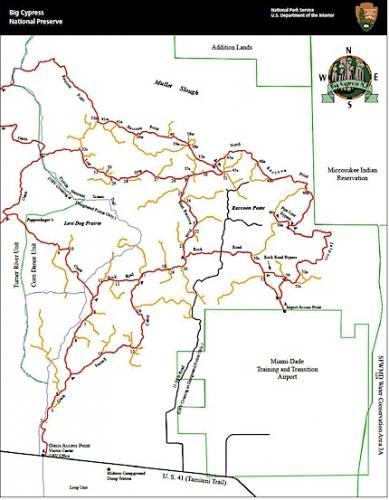National Park Service officials are facing a potential lawsuit over off-road vehicle access in Big Cypress National Preserve in Florida, where opponents say preserve officials are over-reaching with trail networks.
As an example, they point to the preserve's Corn Dance Unit, where the preserve's current implementation of the ORV plan calls for 65 miles of primary trails, and 62 miles of secondary trails, an amount a coalition of conservation groups says violate the preserve's 2000 ORV plan.
"They’ve essentially doubled the amount of use envisioned for the Corn Dance Unit,” Mathew Schwartz, executive director of the South Florida Wildlands Association, said Tuesday evening. “They're just going crazy with these secondary trails. This is not in the spirit of the plan, it violates the letter of the plan to really rein in" ORV use.
Big Cypress has been the focus of several challenges in recent years over its management plans. The Park Service is being sued for decisions concerning off-road vehicle access in landscapes considered to be key to more than a few plant and animal species listed as threatened or endangered. Foremost in this leafy and swampy wild kingdom is the Florida panther, which has been described as the most-endangered mammal in North America.
Last July, a federal court ruled the Park Service acted without sound reasoning in 2007 when it reopened more than 22 miles of off-road vehicle trails in the Bear River Unit of the preserve. In its ruling, the court ordered that the routes be closed.
Courts currently are reviewing the decision by preserve Superintendent Pedro Ramos to open much of the Addition Lands Unit of Big Cypress to ORV use. The Addition Lands had been closed to both ORV use and ORV-assisted hunting ever since they came to the preserve in 1996 while officials worked on developing a management plan for the area. Of the thousands of species of flora and fauna found in the Addition Lands, nearly 100 plants are listed by the State of Florida as endangered or threatened while 29 animal species have federally protected status.
In a notice of their intent to sue the Park Service over the updated ORV routing, the South Florida Wildlands Association, Center for Biological Diversity, Wildlands CPR, the Sierra Club, and Brian Scherf contend that the plans violate the Endangered Species Act, the National Environmental Policy Act, and the National Park Service Organic Act.
"These clearcut legal violations are only bolstered by a recent ruling by a federal judge, which interpreted the meaning of pertinent provisions of the ORV Plan, and which expressly forecloses NPS from designating the secondary trail system in the way that it has in the Corn Dance Unit and Turner River Unit," the notice reads.
Driving the threatened litigation is the groups' contention that the preserve's 2000 off-road vehicle plan be limited to 400 miles the amount of primary ORV routes in the preserve. While that plan carried ORV route limits for the Bear Island, Corn Dance, and Turner River units, preserve officials recently have opened up much more terrain, in part through the approval of secondary trail routes, the groups maintain.
Secondary trails, they add, were supposed to provide access to inholdings, designated campgrounds, and hunting camps, and not for general recreational purposes.
As an example of the perceived overreach, the groups pointed to the approved trail plan for the Corn Dance Unit. It contains 65 miles of primary trails and 62 miles of secondary routes.
"Thus, NPS has designated 127 miles of ORV trails in this unit, which is more than double what the ORV Plan authorized, and significantly larger than the trail system (the U.S. Fish and Wildlife Service) analyzed in its biological opinion," the notice of intent to sue stated.
A similar scenario exists in the Turner Unit, where the 2000 ORV plan called for approximately 140 miles of trails but the latest plan authorizes more than 200 miles of trail, of which 82.5 miles are designated as secondary routes, the document adds.
"Moreover, many secondary trails in these units appear to have no specific purpose other than to access hunting locations – something which the ORV Plan prohibits, and which Judge Steele expressly forbid," the groups added, referring to U.S. District Judge John Steele's ruling last summer on ORV trail planning for the Bear River Unit.
“They’re increasing recreational riding and bringing impacts to the preserve," said Mr. Schwartz.
In threatening to sue, the groups maintain that the "NPS has circumvented the NPS Organic Act and the Big Cypress Establishment Act – which formed the basis of the ORV Plan – by failing to conduct an impairment analysis to determine whether a secondary trail network of this immense size, and the secondary trails on an individual basis, satisfy the non-impairment mandate of the Organic Act. Nor has NPS even attempted to reconcile its decision with the enabling statute’s mandate that NPS administer the Preserve 'in a manner which will assure [its] natural and ecological integrity in perpetuity' by developing 'rules and regulations' which are 'necessary and appropriate to limit or control' potentially destructive practices on the preserve, specifically including the use of 'motorized vehicles' and 'hunting.'"




Add comment